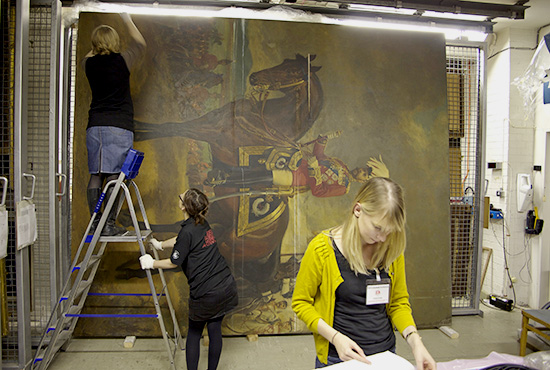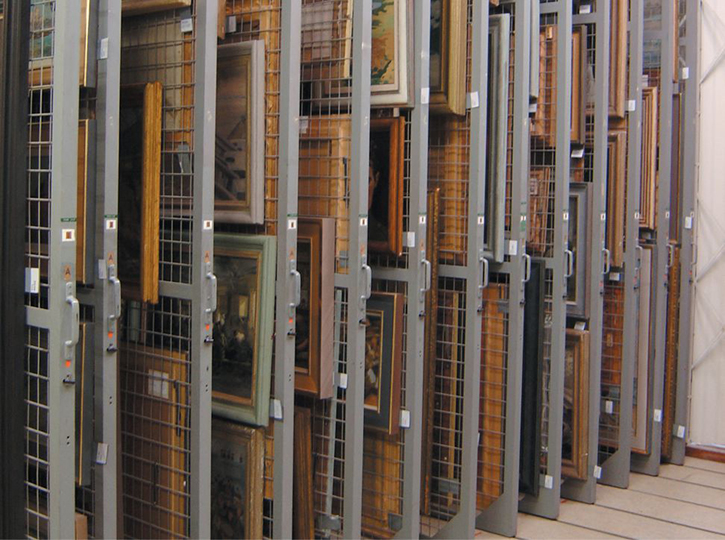
What is the difference between conservation and restoration?
Conservation is the preservation of an object in a stable state for long-term enjoyment. This includes preventative conservation – the creation of stable and harm-free environments to prevent or reduce the effects of decay on a daily basis – and good practice in storage, packing, handling, framing and glazing.
Restoration of paintings, for example, can include the removal of old discoloured varnish, the repair of damage, the removal of later overpainting and retouching. The aim of restoration is to return the artwork as far as possible to a state which reflects the artist's intentions. Naturally, this is an area which often gives rise to debate and controversy in the art world.
What is an oil painting?
Oil paint is a mixture of opaque and translucent pigments held in suspension in an oil 'medium', most usually linseed oil. Over time, many months, the oil 'dries' and hardens through irreversible chemical reactions. The oil paint is applied to a support, now most commonly canvas, but in previous centuries wood, metal or stone have been used. Oil sketches and small paintings are often made on paper or card. There is often a base layer, or 'ground', between the support and the paint, and a layer of varnish on top of the paint layer (although many modern paintings are unvarnished). All these provide long-term stability to the resulting painting. However, in the twentieth century, artists have increasingly used novel and experimental materials and techniques that sometimes make long-term preservation more difficult.
Framing and glazing
Frames have several functions. They provide a distinct visual boundary between the image and the surrounding wall; they protect the painting and allow for safe handling; they can themselves be ornamental features of a decorative or historic interior. Historic frames are often themselves valuable, and fragile objects, which themselves may require conservation.
Glazing protects the paintings from dust, atmospheric pollution, rapid changes of temperature and humidity, but can make dark paintings hard to see, especially if they face a window. Glass is cheap but fragile; perplex is light and strong, but scratches easily and attracts dust. Non-reflective and laminated glass is often used in museums but is expensive.
A backboard is a useful addition, to protect the vulnerable canvas, to buffer environmental changes and keep out dust and insects. Glazing and backboards should be fitted by professional conservators.
Craquelure on the 'Mona Lisa'
(detail), c.1503–c.1517, oil on panel by Leonardo da Vinci (1452–1519) 
Natural ageing of oil paintings
Oil paintings change naturally and irreversibly with age. Over time the paint and ground layers develop a network of fine 'age' cracks, or 'craquelure', mainly due to repeated slight expansion and contraction of the support. This is normal and usually of no concern. Indeed it can often be evidence of the age and authenticity of a painting.
Many paintings, particularly from the eighteenth and nineteenth centuries, have deteriorated due to the use of additives such as resins or bitumen in the paint to provide warm and transparent effects. These interfere with the normal drying of the oil and can produce unsightly lumps and 'alligator-skin' drying cracks. This effect is irreversible.
Some pigments fade, darken or change colour over time, and oil paint mixtures may also become more translucent as they age, so the relative strength of colours can change, upsetting the artist's original intentions. Changes made by the artist during the painting process ('pentimenti') also become more visible. Pigment change and increased translucency are also irreversible.
Traditional varnishes yellow over time, disguising the artist's colours and diminishing tonal and colour contrasts. However, this form of darkening and yellowing can be rectified, and removal of old discoloured varnish is a major part of routine restoration work.
What is sculpture?
Over the centuries, the term sculpture has evolved to encompass a myriad of different forms – reliefs, monuments, tombs, busts, statues, carvings, effigies, assemblages, installations, earth arts – the list goes on, and is also subject to many interpretations.
Sculpture is a term which refers to three-dimensional art being made using one of the four basic processes of carving, modelling, casting and constructing.
Carving is a sculptural technique that involves using tools to shape a form by cutting or scraping away from a solid material such as stone, wood, ivory or bone.
Casting involves making a mould and then pouring a liquid material, such as molten metal, plastic, rubber or fibreglass into the mould. This can then be used more than once, allowing artists to create editions of a particular artwork.
Modelling is an additive process which means that a soft material is worked by the artist to build up a shape or form, rather than scraping the material away as in carving. Also, unlike carving, soft materials such as clay and wax can be changed and reworked before creating the final sculpture.
Constructing and assembling sees artists using a wide range of techniques such as bending, folding, stitching, welding, bolting, tying, weaving, and balancing to form sculptures from various materials and found objects.
Managing collections
Collections care is the most fundamental activity when it comes to safeguarding objects. This term is all-encompassing and recognises your duty to appropriately store, display and handle your collection while at the same time making it as accessible to the wider audience as possible.
Good documentation is the foundation of a strong, accessible and well-managed collection and can easily be kept on top of as long as you don't create backlogs and keep the acquisition process under control. A lot of information relating to an object can be obtained on the day it is acquired. The easiest way of capturing this information is by having a sound object entry process which starts with an Object Entry Form.
Follow the guidance and procedures laid out in Spectrum 5.0 to make sure you are documenting your collection in the best and most comprehensive way possible.
Choosing the right collections management system for your museum is another form of safeguarding your collection. There are many companies out there claiming to have the best system but it all depends on your size of collection, how you need to access it (whether desktop or cloud-based), the type of information you want to record and how you want to search and report on it. To help you choose, the Collections Trust offer a software selection tool which drills down your requirements until you are left with a list of potential systems.
Labelling and marking artworks
Every object in a museum collection must carry its identity number at all times, so that it can be linked to the information a museum holds about that particular object. There are a few basic things to consider when labelling and/or marking sculptures within your collection:
- Make sure the method used is secure. The chances of accidental removal of the label or mark from the object must be extremely low.
- The method must also be reversible. It should be possible to remove the mark or label intentionally from the object, even after 50 to 100 years with ease and leaving as little trace as possible.
- It also has to be safe for the object with both the materials applied and the method by which they are applied not causing any significant damage to the object.
- When objects are made from a number of different materials, always mark the most durable or stable material. If all of the materials are fragile, use a tie-on label.
- Use a standard and easily accessible location for the position of the accession number. For example, the reverse or bottom right-hand corner. This will minimise handling and possible damage when trying to locate the number.
- Practice the chosen marking method until you feel confident enough to apply it safely and successfully to the object.
- Always ensure handwriting is legible. It should be neat and an appropriate size in relation to the mass of the object.
- Never, for the sake of cheapness and convenience, substitute non-archive alternatives such as Tipp-Ex or clear nail varnish for white ink and Paraloid B72.
Picture racking in a museum store
Storing collections
The purpose of storage is to retain objects as a source of information, education and display, by preserving them in as near as possible, their present condition. Stores are an essential part of any museum, gallery and heritage site as it is highly unlikely that your whole collection will be available to be used and/or displayed at any one time. Therefore, it is paramount to make sure that all objects are stored as appropriate to their needs in order to preserve and make them readily retrievable for the future.
The storage location needs to fulfil the following:
- Collections have their environment monitored and modified to meet the recommended conditions for storage.
- There is an even density of objects throughout the storage space to maximise the storage environment.
- Objects are stored using inert materials which pose no threat to collections.
- If the composite materials require it, objects are stored in specialised conditions.
- Fragile and/or highly significant objects are placed on specifically made or shaped supports which provide the highest level of protection.
- All storage locations are marked on object records, including where applicable: box number, shelf number, bay number, aisle number and room number.
It is fundamental that objects, when kept in store, are not placed directly onto the floor but either on shelves, in cupboards or raised up on blocks; preventing damage caused by such things as water ingress, being knocked over and the accumulation of dust and dirt. The best way to achieve this for sculpture depends on their size and weight.
Small sculptures can be fitted into Really Useful Boxes, which are made from polypropylene, a chemically inert material which will not off-gas or harm its contents in any way. Make sure to pad the boxes either with acid-free tissue pillows to rest the sculpture on or carve layers of Plastazote to support the unique shape. Once the lid is secured, these boxes then form a dust-free environment too. They can then be stacked and placed on shelving within the collection store, keeping used space to a minimum and making them readily retrievable for transfer to the display area.
Larger sculptures should still be protected and this can be done either by having bespoke travel crates made and fitted out to support and cushion the sculpture or by just covering them with an inert 'dust sheet' such as a sheet of Tyvek.
Whichever method is used to store the sculptures, make sure the outer layer is labelled to say that it contains a fragile artwork with an image of its contents and details.
Paintings should not be tightly wrapped when in storage, particularly not in plastic sheets or bubble wrap. Good ventilation reduces the chance of mould. In museums, paintings are normally hung on sliding or fixed racking. Paintings can be stacked on the floor or on shelves, if padded with blankets or polyethylene foam sheets and separated by padding or polyethylene foam. Make sure frames are resting on other padded frames, not on other paintings, front or back. Stand or hang paintings vertically, the right way up.
Showcasing sculpture
One of the primary missions of a museum is to interpret cultural heritage through the collection objects in its stewardship by placing them on public display.
There is a balancing act to master as the museum environment has to be both comfortable for the visiting public and the objects on display.
Temperature is usually kept around 19°C for human contentment and as long as this is kept stable then this is not detrimental to most materials. It is the constant footfall which can increase fluctuations in relative humidity and create dust particles to land on the surfaces of sculptures so remember that de-humidifiers can be introduced as and when necessary and programme regular housekeeping which will keep dust levels to an absolute minimum.
Using appropriate display cases is the ideal way to create a 'room within a room', to protect its contents from external fluctuations and dust accumulation. The interior environment of the display case can be altered and maintained at a desired humidity level by the use of silica products or mechanical humidifiers, depending on the sculpture's specific requirements.
Of course, some sculptures are too large for a display case and so the actual room it is exhibited in becomes the display case, with fluctuations being controlled at the main point of entrance by keeping doors closed, making sure they are sealed when shut and placing controllers within the room. Also, limiting visitor numbers at any one time will help control fluctuations.
Information about further guidance and resources can be found on our page of useful links.